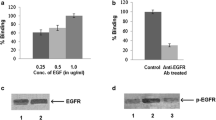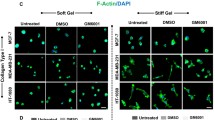Abstract
Cell adhesion to the extracellular matrix appears to trigger a cascade of intracellular signalings. We have previously shown that treatment of ovarian cancer cells, NOM1, with fibronectin (FN) stimulated matrix metalloproteinase (MMP)-9 secretion and thereby activated the invasiveness of cells via the FAK/Ras signaling pathway. By use of chemical inhibitors, we investigated the downstream effectors critical for FN-dependent secretion of MMP-9. Treatment of cells with MEK1 inhibitors, U0126 and PD98059, dramatically suppressed the secretion of MMP-9 activated by FN. Similarly, PI-3 kinase inhibitors, Wortmannin and LY294002, strongly suppressed the FN-dependent secretion of MMP-9 together with the inhibition of Akt activation. In contrast, a specific PKC inhibitor (GF109203X) showed no inhibitory effect on the FN-dependent MMP-9 secretion. Moreover, we found that both the MEK1 inhibitor and the PI3-K inhibitor, but not the PKC inhibitor, strongly suppressed the invasiveness of NOM1 cells. Taken together, our results suggest that activation of dual signaling pathways, MEK1-MAPK and PI3K-Akt, is required for the FN-dependent activation of MMP-9 secretion. Our results suggest the importance of these signaling molecules as a chemotherapeutic target for cancer.
Similar content being viewed by others
References
Liotta LA, Tryggvason K, Garbisa S et al. Metastatic potential correlates with enzymatic degradation of basement membrane collagen. Nature 1980; 284: 67–8.
Liotta LA, Rao CN, Barsky SN. Tumor invasion and the extracellular matrix. Lab Invest 1983; 49: 636–49.
Kataoka M, Yamagata S, Akiyama S et al. Matrix matelloproteinase 2 and in Esophageal cancer: correlation with organ metastasis. Int J Oncol 1996; 8: 773–9.
Sato H, Seiki M. Regulatory mechanism of 92-kDa type IV collagenase gene expression which is associated with invasiveness of tumor cells. Oncogene 1993; 8: 395–405.
Davies B, Waxman J, Wasen H et al. Levels of matrix metalloproteinases in bladder cancer correlated with tumor grade and invasion. Cancer Res 1993; 53: 5365–9.
Rao JS, Steck PA, Mohanam S et al. Elevated level of Mr 92,000 type IV collagenase in human brain tumors. Cancer Res 1993; 53: 2208–11.
Bernhard EJ, Gruber SB, Muschel RJ. Direct evidence linking expression of matrix metalloproteinase 9 (92-kDa gelatinase/collangenase) to the metastatic phenotype in transformed rat embryo cells. Proc Natl Acad Sci USA 1994; 91(10): 4293–7.
Garbisa S, Pozzatti R, Muschel RJ et al. Secretion of type IV collagenolytic protease and metastatic phenotype: induction by transfection with c-Ha-ras but not c-Ha-ras plus Ad2-E1a. Cancer Res 1987; 47(6): 1523–8.
Shibata K, Kikkawa F, Nawa A et al. Increased matrix metalloproteinase 9 activity in human ovarian cancer cells cultured with conditioned medium from human peritoneal tissue. Clin Exp Metastasis 1997; 15: 612–9.
Shibata K, Kikkawa F, Nawa A et al. Fibronectin secretion from human peritoneal tissue induces Mr 92,000 type IV collagenase expression and invasion in ovarian cancer cell lines. Cancer Res 1997; 57: 5416–20.
Clark EA, Brugge JS. Integrins and signal transduction pathways: the road taken. Science 1995; 268(5208): 233–9.
Shibata K, Kikkawa F, Nawa A et al. Both focal adhesion kinase and c-Ras are required for the enhanced matrix metalloproteinase 9 secretion by fibronectin in ovarian cancer cells. Cancer Res 1998; 58: 900–3.
Campbell SL, Khosrvi-Far R, Rossman KL et al. Increasing complexity of Ras signaling. Oncogene 1998; 17: 1395–413.
Egan SE, Weinberg RA. The pathway to signal acheivement. Nature 1993; 365: 781–3.
Reddy KB, Krueger JS, Kondapaka SB et al. Mitogen-activated protein kinase (MAPK) regulates the expression of progelatinase B (MMP-9) in breast epithelial cells. Int J Cancer 1999; 82: 268–73.
Esparza J, Vilardell C, Calvo J et al. Fibronectin upregulates gelatinase B (MMP-9) and induces coordinated expression of gelatinase A (MMP-2) and its activator MT1-MMP (MMP-14) by human T lymphocyte cell lines. A process repressed through Ras/MAP Kinase signaling pathways. Blood 1999; 94: 2754–66.
Nadal F, Lévy-Toledano S, Grelac F et al. Negative regulation of mitogen-activated protein kinase activation by Integrin αIIβ3 in platelets. J Biol Chem 1997; 272: 22381–4.
Gum R, Wang H, Lengyel E et al. Regulation of 92 kDa type IV collagenase expression by jun aminoterminal kinase-and the extracellular signal-regulated kinase-dependent signaling cascades, Oncogene 1997; 14(12): 1481–93.
Simon C, Goepfert H, Boyd D. Inhibition of the p38 mitogenactivated protein kinase by SB 203580 blocks PMA-induced Mr 92,000 type IV collagenase secretion and in vitro invasion. Cancer Res 1998; 58(6): 1135–9.
Gum R, Lengyel E, Juarez J et al. Stimulation of 92-kDa gelatinase B promoter activiti by ras is mitogen-activated protein kinase kinase 1-independent and requires multiple transcription factor binding sites including closely spaced PEA3/ets and AP-1 sequences. J Biol Chem 1996; 271(18): 10672–80.
Moore DH, Allison B, Look KY et al. Collagenase expression in ovarian cancer cell lines. Gynecol Oncol 1997; 65: 78–82.
Huang X, Wu J, Spong S et al. The integrin alphaVbeta6 is critical for keratinocyte migration on both its known ligand, fibronectin, and on vitronectin. J Cell Sci 1998; 111: 2189–95.
Kurata H, Thant AA, Matsuo S et al. Constitutive activation of MAP Kinase Kinase (MEK1) is critical and sufficient for the activation of MMP-2. Exp Cell Res 2000; 254: 180–8.
Nielsen M, Svejgaard A, Skov S et al. IL-2 induces β 2-integrin adhesion via a wortmannin/LY294002-sensitive, rapamycin-resistant pathway. Phosphorylation of a 125-kilodalton protein correlates with induction of adhesion, but not mitogenesis. J Immunol 1996; 157: 5350–8.
Burgering BMT, Coffer PJ. Protein kinase B (c-Akt) in phosphatidylinositol-3-OH kinase signal transduction. Nature 1995; 376: 599–602.
Hamaguchi M, Yamagata S, Thant AA et al. Augmentation of metalloproteinase ( gelatinase ) activity secreted from Rous sarcoma virusinfected cells correlates with transforming activity of src. Oncogene 1995; 10: 1037–43.
Thant AA, Sein TT, Liu E et al. Ras pathway is required for the activation of MMP-2 secretion and for the invasion of src-transformed 3Y1. Oncogene 1999; 18: 6555–63.
Saiki I, Murata J, Nakajima M et al. Inhibition of sulfated chitinderivatives of invasion through extracellular matrix and enzymatic degradation by metastatic melanoma cells. Cancer Res 1990; 50: 3631–7.
Hamaguchi M, Matsuyoshi N, Ohnishi Y et al. p60v-src causes tyrosine phosphorylation and inactivation of the N-cadherin-catenin cell adhesion system. EMBO J 1993; 12: 307–14.
Huhtala P, Humphries MJ, McCarthy JB et al. Cooperative signaling by alpha 5 beta 1 and alpha 4 beta 1 integrins regulates metalloproteinase gene expression in fibroblasts adhering to fibronectin. J Cell Biol 1995; 129: 867–79.
Yamamoto H, Itoh F, Hinoda Y et al. Expression of matrilysin mRNA in colorectal adenomas and its induction by truncated fibronectin. Biochem Biophys Res Commun 1994; 201: 657–64.
Kapila YL, Kapila S, Johnson PW. Fibronectin and fibronectin fragmants modulate the expression of proteinases and proteinase inhibitors in human peritoneal ligament cells. Matrix Biol 1996; 15: 251–61.
Reich R, Blumenthal M, Liscovitch M. Role of phospholipase D in laminin-induced production of gelatinase A (MMP-2) in metastatic cells. Clin Exp Metastasis 1995; 13: 134–40.
Wynmann MP, Pirola L. Structure and function of phosphoinositide 3-kinases. Biochem Biophys Acta 1998; 1436: 127–50.
Chang HW, Aoki M, Fruman D et al. Transformation of chicken cells by the gene encoding the catalytic subunit of PI3-kinase. Science 1997; 276: 1848–50.
Author information
Authors and Affiliations
Rights and permissions
About this article
Cite this article
Thant, A.A., Nawa, A., Kikkawa, F. et al. Fibronectin activates matrix metalloproteinase-9 secretion via the MEK1-MAPK and the PI3K-Akt pathways in ovarian cancer cells. Clin Exp Metastasis 18, 423–428 (2000). https://doi.org/10.1023/A:1010921730952
Issue Date:
DOI: https://doi.org/10.1023/A:1010921730952




